Experimental and Geant4 Simulation Study of MURA Mask for Scintimammography
Abstract
:1. Introduction
2. Materials and Methods
2.1. Experimental Setup
2.2. Simulation Procedure
2.3. Decoding Program
3. Results and Discussion
3.1. Geant4 Benchmark
3.2. Simulation Extended Work
4. Conclusions
Author Contributions
Funding
Institutional Review Board Statement
Informed Consent Statement
Data Availability Statement
Acknowledgments
Conflicts of Interest
Abbreviations
| MURA | Modified Uniformly Redundant Array |
| FWHM | Full Width at Half Maximum |
| PSF | Point Spread Function |
| FOV | Field Of View |
| TBR | Tumor-to-Background Ratio |
References
- Mladenov, A.; Stankov, D.; Nonova, T.; Krezhov, K. Radiation protection, radioactive waste management and site monitoring at the nuclear scientific experimental and educational centre IRT-Sofia at INRNE-BAS. Radiat. Prot. Dosim. 2014, 162, 176–181. [Google Scholar] [CrossRef] [PubMed]
- Ambrosino, F.; Thinova, L.; Briestensky, M.; Giudicepietro, F.; Roca, V.; Sabbarese, C. Analysis of geophysical and meteorological parameters influencing 222Rn activity concentration in Mladec caves (Czech Republic) and in soils of Phlegrean Fields caldera (Italy). Appl. Radiat. Isot. 2020, 160, 109140. [Google Scholar] [CrossRef] [PubMed]
- Zhang, K.; Zeng, Y.; Liu, Z.; Cao, H.; Zhu, W. Investigation on the radiation decontamination of lanthanum oxide during its production from ion-adsorption rare earth ores in China. Hydrometallurgy 2019, 189, 105117. [Google Scholar] [CrossRef]
- Das, B.K.; Biswal, B.M.; Bhavaraju, M. Role of scintimammography in the diagnosis of breast cancer. Malays. J. Med. Sci. 2006, 13, 52–57. [Google Scholar]
- Paradiso, V.; Crivellaro, A.; Amgarou, K.; de Lanaute, N.B.; Fua, P.; Lienard, E. A versatile calibration procedure for portable coded aperture gamma cameras and RGB-D sensors. Nucl. Instrum. Methods Phys. Res. A 2018, 886, 125–133. [Google Scholar] [CrossRef]
- Amgarou, K.; Paradiso, V.; Patoz, A.; Bonnet, F.; Handley, J.; Couturier, P.; Becker, F.; Menaa, N. A comprehensive experimental characterization of the iPIX gamma imager. J. Instrum. 2016, 11, 08012. [Google Scholar] [CrossRef] [Green Version]
- Sun, S.; Zhang, Z.; Shuai, L.; Li, D.; Wang, Y.; Liu, Y.; Huang, X.; Tang, H.; Li, T.; Chai, P. Development of a panorama coded-aperture gamma camera for radiation detection. Radiat. Meas. 2015, 77, 34–40. [Google Scholar] [CrossRef]
- Sun, S.; Zhang, Z.; Shuai, L.; Li, D.; Wang, Y.; Liu, Y.; Huang, X.; Tang, H.; Li, T.; Chai, P. Far field 3D localization of radioactive hot spots using a coded aperture camera. Appl. Radiat. Isot. 2016, 107, 177–182. [Google Scholar]
- Dubos, S.; Lemaire, H.; Schanne, S.; Limousin, O.; Carrel, F.; Schoepff, V.; Blondel, C. ORIGAMIX, a CdTe-based spectro-imager development for nuclear applications, Nucl. Instrum. Methods Phys. Res. A 2015, 787, 302–307. [Google Scholar] [CrossRef] [Green Version]
- Zhang, R.; Gong, P.; Tang, X.; Wang, P.; Zhou, C.; Zhu, X.; Gao, L.; Liang, D.; Wang, Z. Reconstruction method for gamma-ray coded-aperture imaging based on convolutional neural network. Nucl. Instrum. Methods Phys. Res. A 2019, 934, 41–51. [Google Scholar] [CrossRef]
- Kadri, O.; Alfuraih, A. Monte Carlo assessment of coded aperture tool for breast imaging: A Mura-mask case study. Nucl. Sci. Tech. 2019, 30, 164. [Google Scholar] [CrossRef]
- Zhang, T.; Wang, L.; Ning, J.; Lu, W.; Wang, X.F.; Zhang, H.W.; Tuo, X.G. Simulation of an imaging system for internal contamination of lungs using MPA-MURA coded aperture collimator. arXiv 2021, arXiv:2101.07442. [Google Scholar] [CrossRef]
- Penacchioni, A.V.; Braga, J.; Castro, M.A.; D’Amico, F. Telescope performance and image simulations of the balloon-borne coded-mask protoMIRAX experiment. J. High Energy Astrophys. 2015, 5–6, 22–29. [Google Scholar] [CrossRef] [Green Version]
- Accorsi, R.; Lanza, R.C. Near-field artifact reduction in planar coded aperture Imaging. Appl. Opt. 2001, 40, 4697–4705. [Google Scholar] [CrossRef]
- Braga, J.; Durao, O.S.C.; Castro, M.; D’Amico, F.; Stecchini, P.E.; Amirabile, S.; Blanco, F.G.; Strauss, C.; Silva, W.; Schad, V.R.; et al. LECX: A cubesat experiment to detect and localize cosmic explosions in hard X-rays. Mon. Not. R. Astron. Soc. 2020, 493, 4852–4860. [Google Scholar] [CrossRef]
- Kasuga, T.; Odaka, H.; Hatauchi, K.; Takashima, S.; Tamba, T.; Aizawa, Y.; Hashiba, S.; Bamba, A.; Zhou, Y.; Tamagawa, T. Artifact-less Coded Aperture Imaging in the X-ray Band with Multiple Different Random Patterns. arXiv 2020, arXiv:2007.15278. [Google Scholar] [CrossRef]
- Jeong, M.; Hammig, M.D. Comparison of gamma ray localization using system matrixes obtained by either MCNP simulations or ray-driven calculations for a coded-aperture imaging system. Nucl. Instrum. Methods A 2018, 954, 161353. [Google Scholar] [CrossRef]
- Sun, S.; Liu, Y.; Ouyang, X. Near-field high-resolution coded aperture gamma-ray imaging with separable masks. Nucl. Instrum. Methods A 2020, 951, 163001. [Google Scholar] [CrossRef]
- Alnafea, M.; Wells, K.; Spyrou, N.M.; Guy, M. Preliminary Monte Carlo study of coded aperture imaging with a CZT gamma camera system for scintimammography. Nucl. Instrum. Methods A 2007, 573, 122–125. [Google Scholar] [CrossRef]
- Agostinelli, S.; Allison, J.; Amako, K.A.; Apostolakis, J.; Araujo, H.; Arce, P.; Asai, M.; Axen, D.; Banerjee, S.; Barrand, G.J.N.I.; et al. GEANT4-a simulation toolkit. Nucl. Instrum. Methods A 2003, 506, 250–303. [Google Scholar] [CrossRef] [Green Version]
- Beaudoux, V.; Blina, G.; Barbrelb, B.; Kantorc, G.; Zacharatou, C. Geant4 physics list comparison for the simulation of phase-contrast mammography (XPulse project). Phys. Medica 2019, 60, 66–75. [Google Scholar] [CrossRef] [PubMed]
- Rinaldi, L.; Ambrosino, F.; Roca, V.; D’Onofrio, A.; Sabbarese, C. Study of 222-220Rn Measurement Systems Based on Electrostatic Collection by Using Geant4+COMSOL Simulation. Appl. Sci. 2022, 12, 507. [Google Scholar] [CrossRef]
- Berger, M.J.; Coursey, J.S.; Zucker, M.A.; Chang, J. Stopping-Power & Range Tables for Electrons, Protons and Helium Ions; NIST Standard Reference Database 124 2017, NISTIR 4999; National Institute of Standards and Technology: Gaithersburg, MD, USA, 2017. [Google Scholar]
- Allison, J.; Amako, K.; Apostolakis, J.; Arce, P.; Asai, M.; Aso, T.; Bagli, E.; Bagulya, A.; Banerjee, S.; Barrand, G.J.N.I.; et al. Recent developments in GEANT4. Nucl. Instrum. Methods A 2016, 835, 186–225. [Google Scholar] [CrossRef]
- Cosmo, G.; The Geant4 Collaboration. Geant4-towards major release 10. J. Phys. Conf. Ser. 2014, 513, 022005. [Google Scholar] [CrossRef] [Green Version]
- Cieslak, M.J.; Gamage, K.A.; Glover, R. Coded-aperture imaging systems: Past, present and future development—A review. Radiat. Meas. 2016, 92, 59–71. [Google Scholar] [CrossRef]
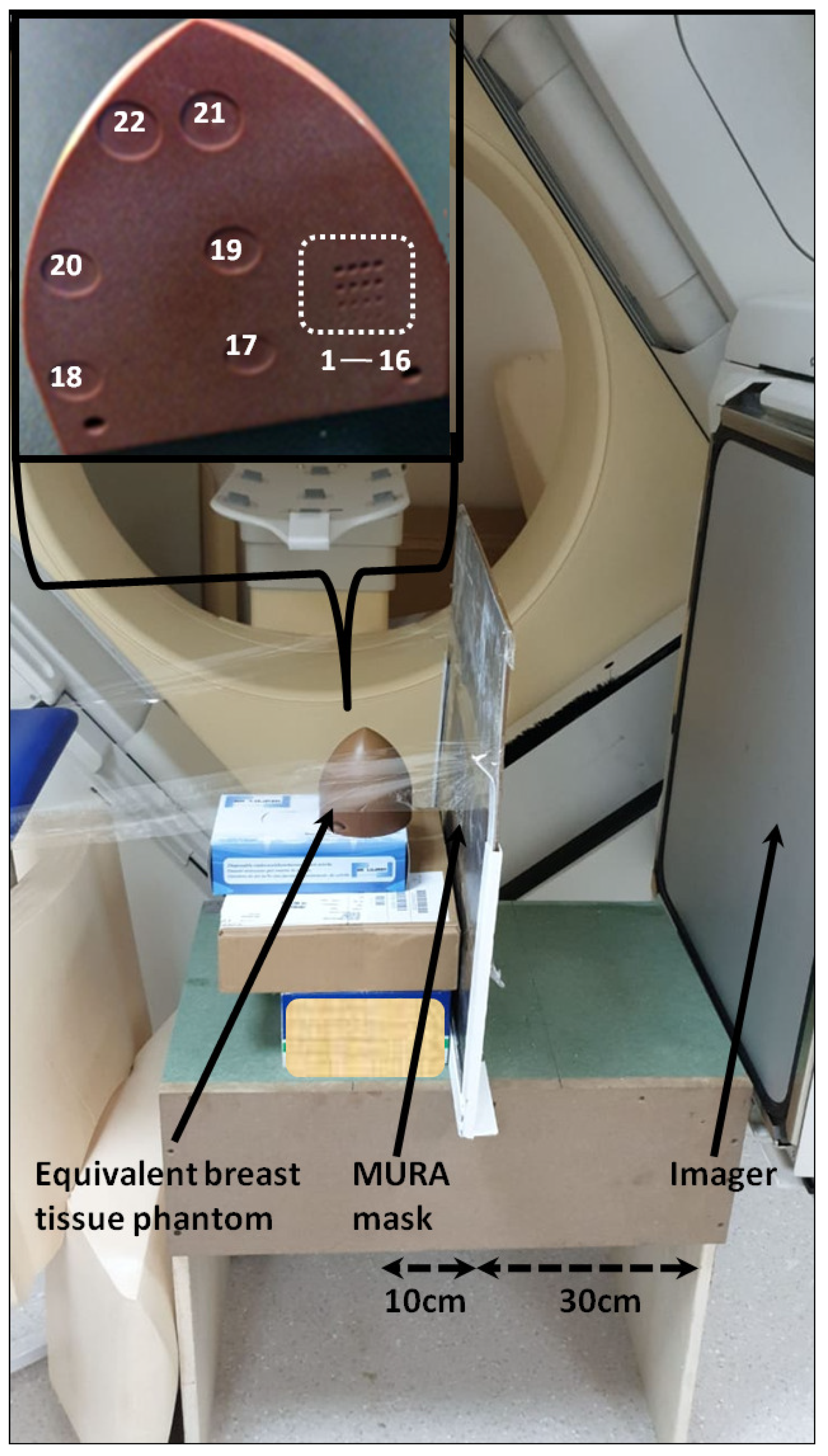
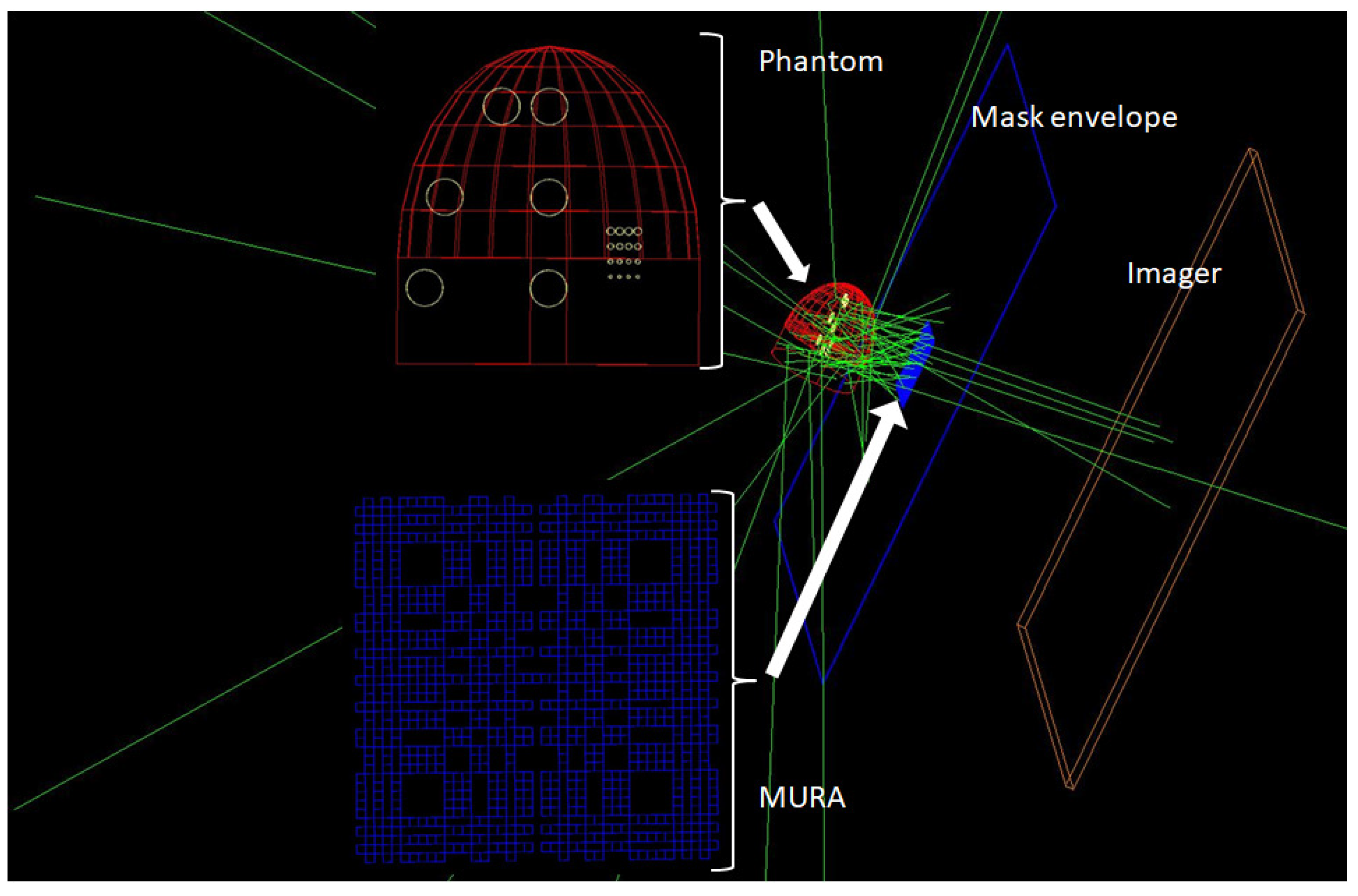
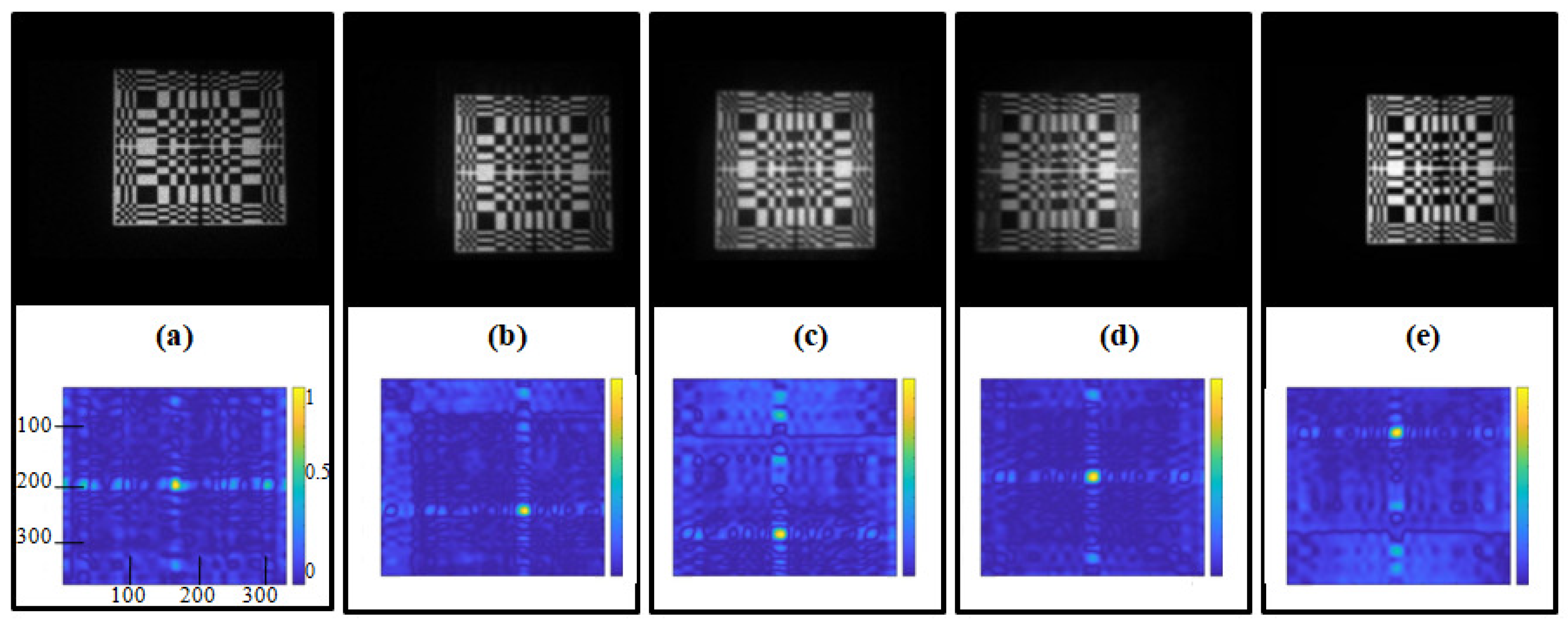
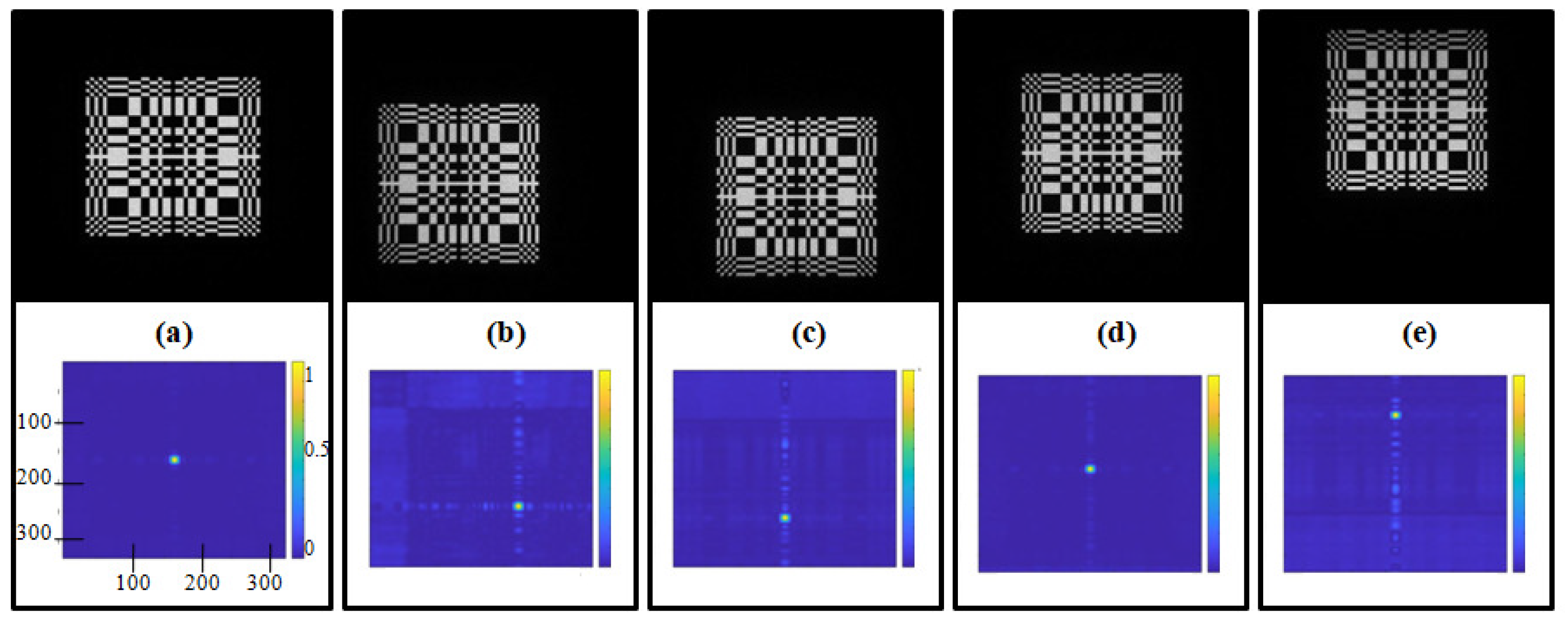

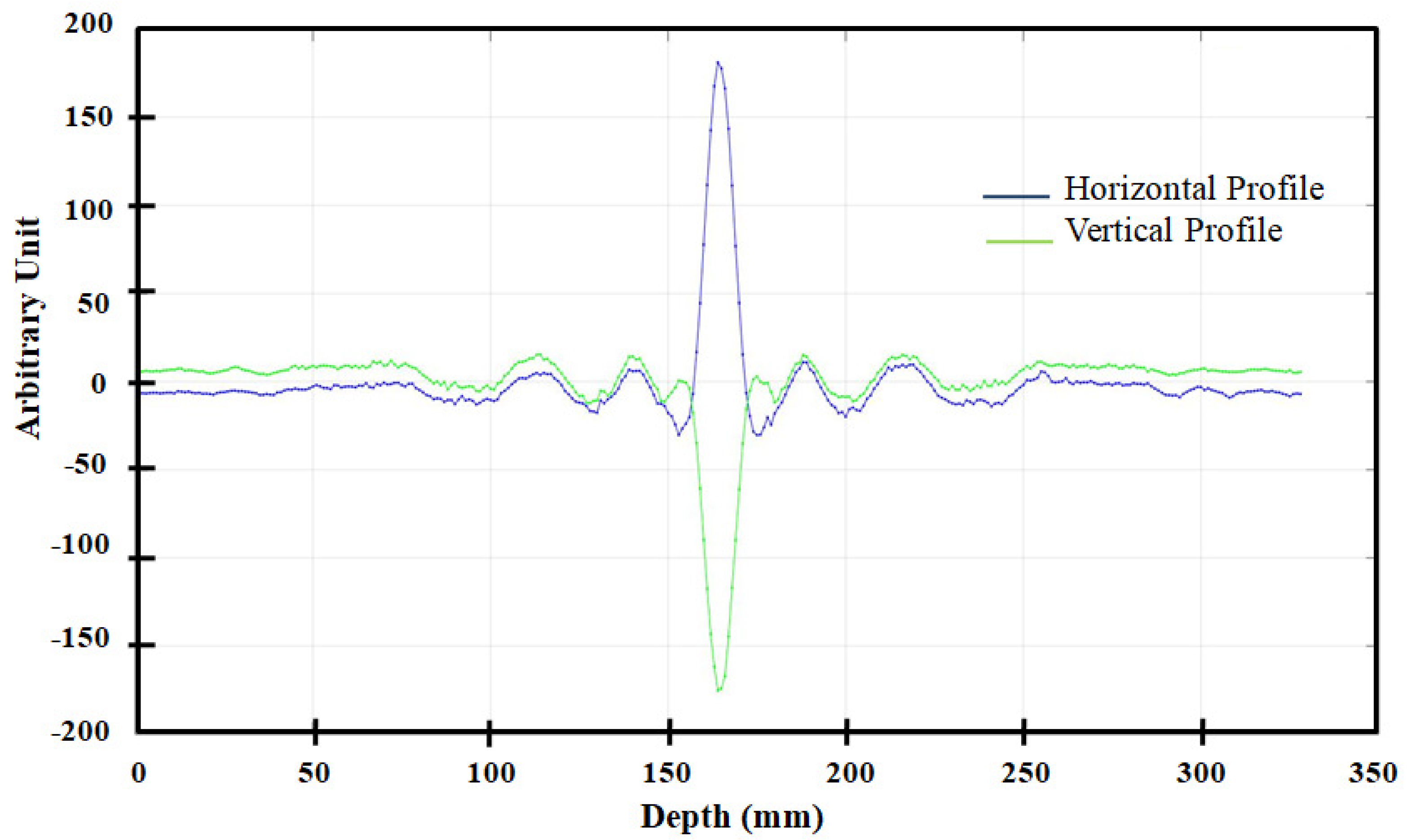
| Location | TBR | FWHM | Contrast | Location | TBR | FWHM | Contrast |
|---|---|---|---|---|---|---|---|
| 1 | 2 | 8.002 | 3.782 | 6 | 2 | 7.838 | 3.830 |
| 3 | 7.985 | 3.968 | 3 | 7.962 | 3.693 | ||
| 4 | 8.004 | 3.455 | 4 | 8.048 | 4.047 | ||
| 5 | 7.932 | 3.686 | 5 | 7.990 | 3.686 | ||
| 6 | 8.004 | 3.664 | 6 | 8.052 | 3.603 | ||
| 7 | 8.049 | 3.978 | 7 | 7.910 | 3.591 | ||
| 8 | 7.990 | 3.914 | 8 | 7.952 | 3.707 | ||
| 9 | 7.885 | 3.914 | 9 | 8.052 | 3.719 | ||
| 10 | 8.055 | 3.855 | 10 | 8.029 | 3.587 | ||
| 2 | 2 | 8.030 | 3.718 | 7 | 2 | 8.015 | 3.571 |
| 3 | 7.998 | 3.268 | 3 | 7.929 | 3.880 | ||
| 4 | 7.931 | 3.608 | 4 | 7.962 | 3.857 | ||
| 5 | 8.042 | 3.616 | 5 | 7.928 | 3.518 | ||
| 6 | 7.909 | 3.856 | 6 | 7.943 | 4.021 | ||
| 7 | 8.053 | 4.059 | 7 | 7.981 | 4.048 | ||
| 8 | 8.049 | 3.736 | 8 | 8.002 | 3.499 | ||
| 9 | 7.975 | 3.320 | 9 | 8.025 | 3.660 | ||
| 10 | 7.971 | 3.524 | 10 | 7.933 | 3.799 | ||
| 3 | 2 | 7.973 | 3.413 | 8 | 2 | 7.990 | 3.827 |
| 3 | 8.021 | 3.739 | 3 | 8.033 | 3.699 | ||
| 4 | 7.986 | 3.467 | 4 | 7.948 | 3.603 | ||
| 5 | 7.982 | 3.788 | 5 | 7.925 | 3.772 | ||
| 6 | 8.002 | 3.819 | 6 | 8.017 | 3.572 | ||
| 7 | 7.927 | 3.615 | 7 | 8.007 | 3.664 | ||
| 8 | 8.018 | 3.959 | 8 | 7.975 | 3.872 | ||
| 9 | 8.069 | 3.678 | 9 | 7.975 | 3.822 | ||
| 10 | 7.977 | 3.418 | 10 | 7.988 | 3.469 | ||
| 4 | 2 | 8.065 | 3.809 | 9 | 2 | 7.948 | 3.975 |
| 3 | 7.936 | 3.623 | 3 | 7.954 | 3.665 | ||
| 4 | 7.993 | 3.871 | 4 | 7.957 | 3.629 | ||
| 5 | 8.018 | 3.398 | 5 | 7.915 | 3.751 | ||
| 6 | 8.009 | 3.844 | 6 | 7.962 | 3.741 | ||
| 7 | 7.940 | 3.990 | 7 | 8.013 | 3.690 | ||
| 8 | 8.010 | 3.601 | 8 | 8.033 | 3.887 | ||
| 9 | 8.005 | 3.784 | 9 | 7.913 | 3.498 | ||
| 10 | 7.999 | 3.871 | 10 | 7.957 | 3.300 | ||
| 5 | 2 | 7.984 | 3.696 | 10 | 2 | 8.085 | 3.845 |
| 3 | 7.897 | 3.871 | 3 | 7.961 | 3.666 | ||
| 4 | 8.004 | 3.465 | 4 | 7.936 | 3.875 | ||
| 5 | 7.973 | 3.842 | 5 | 8.088 | 4.207 | ||
| 6 | 7.939 | 3.700 | 6 | 8.040 | 3.724 | ||
| 7 | 7.918 | 3.740 | 7 | 8.016 | 3.723 | ||
| 8 | 7.975 | 3.914 | 8 | 7.895 | 3.563 | ||
| 9 | 8.009 | 3.685 | 9 | 8.050 | 3.669 | ||
| 10 | 7.949 | 3.721 | 10 | 8.030 | 3.830 | ||
| 11 | 2 | 8.042 | 3.898 | 17 | 2 | 7.993 | 3.699 |
| 3 | 7.978 | 3.701 | 3 | 7.933 | 3.426 | ||
| 4 | 8.025 | 3.811 | 4 | 7.973 | 3.728 | ||
| 5 | 7.838 | 3.352 | 5 | 7.994 | 3.691 | ||
| 6 | 7.964 | 3.831 | 6 | 7.999 | 3.731 | ||
| 7 | 7.999 | 4.126 | 7 | 7.931 | 3.892 | ||
| 8 | 7.958 | 3.399 | 8 | 7.981 | 3.505 | ||
| 9 | 8.035 | 3.776 | 9 | 7.927 | 3.852 | ||
| 10 | 7.956 | 3.635 | 10 | 8.050 | 3.821 | ||
| 12 | 2 | 7.955 | 3.651 | 18 | 2 | 8.020 | 4.075 |
| 3 | 8.010 | 3.537 | 3 | 7.930 | 3.570 | ||
| 4 | 7.882 | 3.889 | 4 | 7.984 | 3.372 | ||
| 5 | 7.982 | 3.638 | 5 | 7.961 | 3.897 | ||
| 6 | 7.970 | 3.960 | 6 | 8.046 | 3.640 | ||
| 7 | 7.984 | 3.888 | 7 | 7.911 | 3.520 | ||
| 8 | 8.004 | 3.616 | 8 | 7.987 | 3.530 | ||
| 9 | 7.921 | 3.718 | 9 | 8.078 | 3.667 | ||
| 10 | 7.986 | 4.050 | 10 | 8.001 | 3.992 | ||
| 13 | 2 | 7.995 | 3.593 | 19 | 2 | 7.934 | 3.664 |
| 3 | 7.966 | 4.072 | 3 | 7.981 | 3.843 | ||
| 4 | 7.984 | 3.590 | 4 | 7.975 | 3.780 | ||
| 5 | 7.977 | 3.505 | 5 | 7.994 | 3.711 | ||
| 6 | 8.006 | 3.748 | 6 | 8.002 | 3.846 | ||
| 7 | 7.988 | 3.812 | 7 | 7.936 | 3.880 | ||
| 8 | 7.973 | 3.770 | 8 | 7.956 | 3.355 | ||
| 9 | 8.081 | 3.859 | 9 | 7.978 | 3.704 | ||
| 10 | 7.944 | 4.022 | 10 | 8.007 | 3.294 | ||
| 14 | 2 | 8.037 | 3.510 | 20 | 2 | 7.949 | 3.830 |
| 3 | 8.000 | 3.707 | 3 | 7.987 | 3.655 | ||
| 4 | 8.023 | 3.612 | 4 | 8.030 | 3.492 | ||
| 5 | 7.925 | 3.930 | 5 | 7.966 | 3.903 | ||
| 6 | 8.015 | 3.519 | 6 | 7.951 | 3.582 | ||
| 7 | 7.979 | 3.843 | 7 | 7.967 | 3.782 | ||
| 8 | 8.015 | 3.523 | 8 | 8.017 | 3.814 | ||
| 9 | 8.033 | 3.440 | 9 | 8.008 | 3.642 | ||
| 10 | 7.936 | 3.542 | 10 | 8.018 | 3.451 | ||
| 15 | 2 | 7.982 | 3.623 | 21 | 2 | 8.007 | 3.502 |
| 3 | 8.007 | 3.745 | 3 | 8.002 | 3.364 | ||
| 4 | 7.959 | 3.696 | 4 | 7.982 | 3.512 | ||
| 5 | 7.975 | 3.742 | 5 | 8.003 | 4.029 | ||
| 6 | 8.005 | 4.063 | 6 | 8.074 | 3.803 | ||
| 7 | 7.974 | 3.718 | 7 | 7.996 | 3.598 | ||
| 8 | 7.957 | 3.642 | 8 | 8.021 | 3.795 | ||
| 9 | 7.935 | 3.886 | 9 | 7.982 | 3.828 | ||
| 10 | 7.955 | 3.499 | 10 | 8.050 | 3.636 | ||
| 16 | 2 | 8.035 | 3.641 | 22 | 2 | 7.989 | 3.661 |
| 3 | 7.985 | 3.487 | 3 | 8.011 | 3.586 | ||
| 4 | 7.968 | 3.722 | 4 | 8.050 | 3.678 | ||
| 5 | 8.069 | 3.465 | 5 | 7.975 | 3.988 | ||
| 6 | 8.084 | 3.713 | 6 | 7.937 | 3.867 | ||
| 7 | 7.999 | 3.587 | 7 | 7.944 | 3.551 | ||
| 8 | 7.935 | 3.718 | 8 | 8.019 | 4.012 | ||
| 9 | 8.054 | 3.496 | 9 | 7.996 | 3.767 | ||
| 10 | 8.019 | 3.637 | 10 | 7.926 | 3.874 |
| FWHM | Contrast | |||
|---|---|---|---|---|
| Location | Average | Stdev | Average | Stdev |
| 1 | 7.989 | 0.053 | 3.802 | 0.173 |
| 2 | 7.989 | 0.051 | 3.600 | 0.256 |
| 3 | 8.005 | 0.045 | 3.699 | 0.175 |
| 4 | 7.988 | 0.030 | 3.742 | 0.181 |
| 5 | 7.958 | 0.040 | 3.742 | 0.141 |
| 6 | 7.982 | 0.074 | 3.718 | 0.145 |
| 7 | 7.966 | 0.036 | 3.790 | 0.197 |
| 8 | 7.979 | 0.035 | 3.716 | 0.159 |
| 9 | 7.976 | 0.056 | 3.667 | 0.180 |
| 10 | 8.002 | 0.065 | 3.782 | 0.197 |
| 11 | 7.968 | 0.057 | 3.698 | 0.233 |
| 12 | 7.970 | 0.042 | 3.765 | 0.184 |
| 13 | 7.995 | 0.041 | 3.765 | 0.205 |
| 14 | 7.990 | 0.038 | 3.637 | 0.162 |
| 15 | 7.978 | 0.032 | 3.737 | 0.160 |
| 16 | 8.014 | 0.052 | 3.603 | 0.110 |
| 17 | 7.979 | 0.043 | 3.747 | 0.197 |
| 18 | 7.981 | 0.055 | 3.650 | 0.192 |
| 19 | 7.975 | 0.024 | 3.694 | 0.218 |
| 20 | 7.995 | 0.028 | 3.647 | 0.158 |
| 21 | 8.011 | 0.032 | 3.692 | 0.196 |
| 22 | 7.982 | 0.044 | 3.790 | 0.175 |
Publisher’s Note: MDPI stays neutral with regard to jurisdictional claims in published maps and institutional affiliations. |
© 2022 by the authors. Licensee MDPI, Basel, Switzerland. This article is an open access article distributed under the terms and conditions of the Creative Commons Attribution (CC BY) license (https://creativecommons.org/licenses/by/4.0/).
Share and Cite
Alnafea, M.A.; Shamma, K.; Kadri, O. Experimental and Geant4 Simulation Study of MURA Mask for Scintimammography. Appl. Sci. 2022, 12, 4890. https://doi.org/10.3390/app12104890
Alnafea MA, Shamma K, Kadri O. Experimental and Geant4 Simulation Study of MURA Mask for Scintimammography. Applied Sciences. 2022; 12(10):4890. https://doi.org/10.3390/app12104890
Chicago/Turabian StyleAlnafea, Mohammed A., Khaled Shamma, and Omrane Kadri. 2022. "Experimental and Geant4 Simulation Study of MURA Mask for Scintimammography" Applied Sciences 12, no. 10: 4890. https://doi.org/10.3390/app12104890
APA StyleAlnafea, M. A., Shamma, K., & Kadri, O. (2022). Experimental and Geant4 Simulation Study of MURA Mask for Scintimammography. Applied Sciences, 12(10), 4890. https://doi.org/10.3390/app12104890







